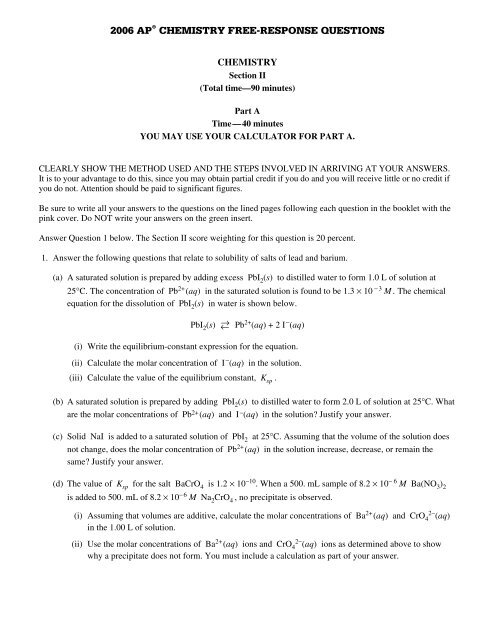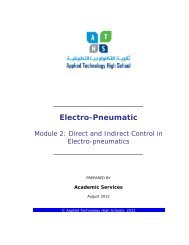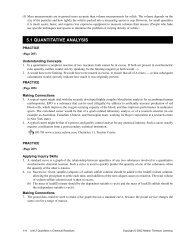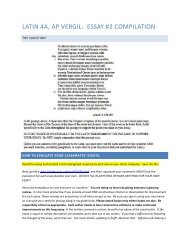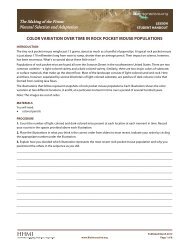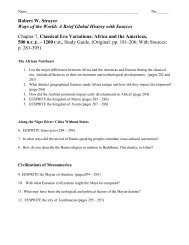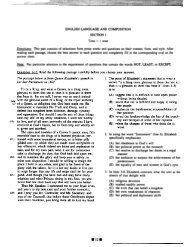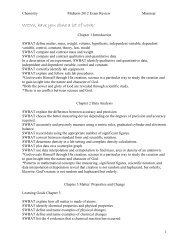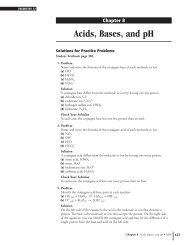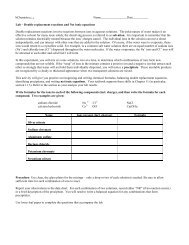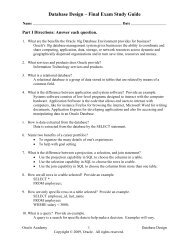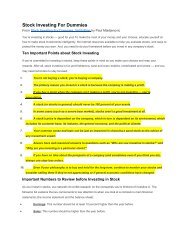Sol Equil KEY - Quia
Sol Equil KEY - Quia
Sol Equil KEY - Quia
Create successful ePaper yourself
Turn your PDF publications into a flip-book with our unique Google optimized e-Paper software.
2006 AP ® CHEMISTRY FREE-RESPONSE QUESTIONS<br />
CHEMISTRY<br />
Section II<br />
(Total time—90 minutes)<br />
Part A<br />
Time—40 minutes<br />
YOU MAY USE YOUR CALCULATOR FOR PART A.<br />
CLEARLY SHOW THE METHOD USED AND THE STEPS INVOLVED IN ARRIVING AT YOUR ANSWERS.<br />
It is to your advantage to do this, since you may obtain partial credit if you do and you will receive little or no credit if<br />
you do not. Attention should be paid to significant figures.<br />
Be sure to write all your answers to the questions on the lined pages following each question in the booklet with the<br />
pink cover. Do NOT write your answers on the green insert.<br />
Answer Question 1 below. The Section II score weighting for this question is 20 percent.<br />
1. Answer the following questions that relate to solubility of salts of lead and barium.<br />
(a) A saturated solution is prepared by adding excess PbI 2 (s) to distilled water to form 1.0 L of solution at<br />
25°C. The concentration of Pb 2+ (aq) in the saturated solution is found to be 1.3 × 10 − 3 M. The chemical<br />
equation for the dissolution of PbI 2 (s) in water is shown below.<br />
PbI 2 (s) → ← Pb 2+ (aq) + 2 I − (aq)<br />
(i) Write the equilibrium-constant expression for the equation.<br />
(ii) Calculate the molar concentration of I − (aq) in the solution.<br />
(iii) Calculate the value of the equilibrium constant, K sp .<br />
(b) A saturated solution is prepared by adding PbI 2 (s) to distilled water to form 2.0 L of solution at 25°C. What<br />
are the molar concentrations of Pb 2+ (aq) and I − (aq) in the solution? Justify your answer.<br />
(c) <strong>Sol</strong>id NaI is added to a saturated solution of PbI 2 at 25°C. Assuming that the volume of the solution does<br />
not change, does the molar concentration of Pb 2+ (aq) in the solution increase, decrease, or remain the<br />
same? Justify your answer.<br />
(d) The value of K sp for the salt BaCrO 4 is 1.2 × 10 −10 . When a 500. mL sample of 8.2 × 10 − 6 M Ba(NO 3 ) 2<br />
is added to 500. mL of 8.2 × 10 − 6 M Na 2 CrO 4 , no precipitate is observed.<br />
(i) Assuming that volumes are additive, calculate the molar concentrations of Ba 2+ (aq) and CrO 4 2− (aq)<br />
in the 1.00 L of solution.<br />
(ii) Use the molar concentrations of Ba 2+ (aq) ions and CrO 4 2− (aq) ions as determined above to show<br />
why a precipitate does not form. You must include a calculation as part of your answer.<br />
© 2006 The College Board. All rights reserved.<br />
Visit apcentral.collegeboard.com (for AP professionals) and www.collegeboard.com/apstudents (for students and parents).<br />
6<br />
GO ON TO THE NEXT PAGE.
AP ® CHEMISTRY<br />
2006 SCORING GUIDELINES<br />
Question 1<br />
1. Answer the following questions that relate to solubility of salts of lead and barium.<br />
(a) A saturated solution is prepared by adding excess PbI 2 (s) to distilled water to form 1.0 L of solution<br />
at 25°C. The concentration of Pb 2+ (aq) in the saturated solution is found to be 1.3 × 10 −3 M . The<br />
chemical equation for the dissolution of PbI 2 (s) in water is shown below.<br />
PbI 2 (s) → ← Pb 2+ (aq) + 2 I − (aq)<br />
(i) Write the equilibrium-constant expression for the equation.<br />
Ksp<br />
2+ 2<br />
= [Pb ][I<br />
−]<br />
One point is earned for the correct expression.<br />
(ii) Calculate the molar concentration of I − (aq) in the solution.<br />
By stoichiometry, [I − ] = 2 × [Pb 2+ ] ,<br />
thus [I − ] = 2 × (1.3 × 10 −3 ) = 2.6 × 10 −3 M<br />
One point is earned for the correct concentration.<br />
(iii) Calculate the value of the equilibrium constant, K sp .<br />
K sp = [Pb 2+ ][I − ] 2 = (1.3 × 10 −3 )(2.6 × 10 −3 ) 2<br />
= 8.8 × 10 −9<br />
One point is earned for a value of K sp that is<br />
consistent with the answers in parts (a)(i) and (a)(ii).<br />
(b) A saturated solution is prepared by adding PbI 2 (s) to distilled water to form 2.0 L of solution at 25°C.<br />
What are the molar concentrations of Pb 2+ (aq) and I − (aq) in the solution? Justify your answer.<br />
The molar concentrations of Pb 2+ (aq) and I − (aq)<br />
would be the same as in the 1.0 L solution in part (a)<br />
(i.e., 1.3 × 10 −3 M and 2.6 × 10 −3 M , respectively).<br />
The concentrations of solute particles in a saturated<br />
solution are a function of the constant, K sp , which is<br />
independent of volume.<br />
One point is earned for the concentrations<br />
(or stating they are the same as in the solution<br />
described in part (a)) and justification.<br />
© 2006 The College Board. All rights reserved.<br />
Visit apcentral.collegeboard.com (for AP professionals) and www.collegeboard.com/apstudents (for students and parents).<br />
2
AP ® CHEMISTRY<br />
2006 SCORING GUIDELINES<br />
Question 1 (continued)<br />
(c) <strong>Sol</strong>id NaI is added to a saturated solution of PbI 2 at 25°C. Assuming that the volume of the solution<br />
does not change, does the molar concentration of Pb 2+ (aq) in the solution increase, decrease, or remain<br />
the same? Justify your answer.<br />
[Pb 2+ ] will decrease.<br />
The NaI(s) will dissolve, increasing [I − ] ; more I − (aq) then combines<br />
with Pb 2+ (aq) to precipitate PbI 2 (s) so that the ion product [Pb 2+ ][I − ] 2<br />
will once again attain the value of 8.8 × 10 −9 (K sp at 25°C).<br />
One point is earned for<br />
stating that [Pb 2+ ] will<br />
decrease.<br />
One point is earned for<br />
justification (can involve a<br />
Le Chatelier argument).<br />
(d) The value of K sp for the salt BaCrO 4 is 1.2 × 10 −10 . When a 500. mL sample of 8.2 × 10 − 6 M<br />
Ba(NO 3 ) 2 is added to 500. mL of 8.2 × 10 − 6 M Na 2 CrO 4 , no precipitate is observed.<br />
(i) Assuming that volumes are additive, calculate the molar concentrations of Ba 2+ (aq) and<br />
CrO 4 2− (aq) in the 1.00 L of solution.<br />
New volume = 500. mL + 500. mL = 1.000 L , therefore [Ba 2+ ]<br />
in 1.000 L is one-half its initial value:<br />
[Ba 2+ ] =<br />
500. mL<br />
1,000. mL × (8.2 × 10− 6 M ) = 4.1 × 10 − 6 M<br />
One point is earned for the<br />
correct concentration.<br />
[CrO 4 2− ] =<br />
500. mL<br />
1,000. mL × (8.2 × 10− 6 M ) = 4.1 × 10 − 6 M<br />
(ii) Use the molar concentrations of Ba 2+ (aq) ions and CrO 4 2− (aq) ions as determined above to show<br />
why a precipitate does not form. You must include a calculation as part of your answer.<br />
The product Q = [Ba 2+ ][CrO 4 2− ]<br />
= (4.1 × 10 − 6 M)(4.1 × 10 − 6 M)<br />
= 1.7 × 10 −11<br />
Because Q = 1.7 × 10 −11 < 1.2 × 10 −10 = K sp ,<br />
no precipitate forms.<br />
One point is earned for calculating a value of<br />
Q that is consistent with the concentration<br />
values in part (d)(i).<br />
One point is earned for<br />
using Q to explain why no precipitate forms.<br />
© 2006 The College Board. All rights reserved.<br />
Visit apcentral.collegeboard.com (for AP professionals) and www.collegeboard.com/apstudents (for students and parents).<br />
3
© 2006 The College Board. All rights reserved.<br />
Visit apcentral.collegeboard.com (for AP professionals) and www.collegeboard.com/apstudents (for students and parents).
AP ® CHEMISTRY<br />
2006 SCORING COMMENTARY<br />
Question 1<br />
Overview<br />
This was a required equilibrium problem designed to assess students’ understanding of solubility and principles<br />
of solubility equilibrium. Students were expected to write an expression for the K sp from the solubility equation,<br />
determine the stoichiometric relationship between concentrations of ions, and calculate the value of the K sp .<br />
They were asked to assess the effect of different volumes of solution on the concentrations of ions in a saturated<br />
solution and the effect of adding a soluble salt containing a common ion. The last part of the question assessed<br />
students’ ability to calculate concentrations of ions from dilution data and to calculate and interpret the value of<br />
Q in comparison to K sp .<br />
Sample: 1A<br />
Score: 9<br />
This response earned all 9 points: 1 point for part (a)(i), 1 point for part (a)(ii), 1 point for part (a)(iii), 1 point for<br />
part (b), 2 points for part (c), 1 point for part (d)(i), and 2 points for part (d)(ii).<br />
Sample: 1B<br />
Score: 7<br />
All of the points were earned in parts (a), (b), and (d). The points were not earned in part (c) because the student<br />
does not show that an increase in [I − ] results in a decrease in [Pb 2+ ].<br />
Sample: 1C<br />
Score: 5<br />
The point was not earned in part (a)(i) because solid PbI 2 is included in the expression. Part (a)(iii) is not<br />
attempted. The point was not earned in part (b) because the concentrations are halved. In part (c) 1 point was<br />
earned for stating that [Pb 2+ ] decreases; however, the justification is insufficient to have earned the second point.<br />
All 3 points were earned in part (d).<br />
© 2006 The College Board. All rights reserved.<br />
Visit apcentral.collegeboard.com (for AP professionals) and www.collegeboard.com/apstudents (for students and parents).
Student Performance Q&A:<br />
2006 AP ® Chemistry Free-Response Questions<br />
The following comments on the 2006 free-response questions for AP ® Chemistry were written by<br />
the Chief Reader, Eleanor Siebert of Mount St. Mary’s College in Los Angeles, California. They<br />
give an overview of each free-response question and of how students performed on the question,<br />
including typical student errors. General comments regarding the skills and content that students<br />
frequently have the most problems with are included. Some suggestions for improving student<br />
performance in these areas are also provided. Teachers are encouraged to attend a College Board<br />
workshop to learn strategies for improving student performance in specific areas.<br />
Question 1<br />
What was the intent of this question?<br />
This question was a required equilibrium problem designed to assess students’ understanding of solubility<br />
and principles of solubility equilibrium. Students were expected to write an expression for the K sp from<br />
the solubility equation, determine the stoichiometric relationship between concentrations of ions, and<br />
calculate the value of the K sp . They were asked to assess the effect of different volumes of solution on the<br />
concentrations of ions in a saturated solution and the effect of adding a soluble salt containing a common<br />
ion. The last part of the question assessed students’ ability to calculate concentrations of ions from<br />
dilution data and to calculate and interpret the value of Q in comparison to K . sp<br />
How well did students perform on this question?<br />
Students did a good job answering the question, earning a mean score of 4.19 out of a possible 9 points.<br />
There was a very flat score distribution, with each score (0–9) accounting for 8 to 12 percent of the<br />
responses (excluding blanks). The comparatively large percentage of 8s and 9s indicated that many<br />
students had mastered the tested concepts. The points were well distributed among the four parts of the<br />
problem, though many responses that scored in the midrange (5–6) earned most of the points on parts (a)<br />
and (d). Students who earned 1–3 points usually earned them in part (a). Part (b) was the most challenging<br />
for students; most of the students who earned 8 points failed to earn the 1 point for part (b).<br />
1<br />
© 2006 The College Board. All rights reserved.<br />
Visit apcentral.collegeboard.com (for AP professionals) and www.collegeboard.com/apstudents (for students and parents).
What were common student errors or omissions?<br />
Part (a)(i): Some students included [PbI 2 ] in the equilibrium constant expression, and some omitted the<br />
charges on Pb 2+ and I − .<br />
Part (a)(ii): Some students indicated that [I − ] = (1.3 × 10 −3 ) 2 = 1.7 × 10 −6 , and some made errors with<br />
significant figures.<br />
Part (a)(ii) and (a)(iii): Some students made errors with significant figures.<br />
Part (b): Many students indicated that the concentration was inversely (or directly) proportional to<br />
volume. Many stated (correctly) that concentration is independent of volume but failed to refer to the<br />
saturated solution, equilibrium, or K sp .<br />
Part (c): Many students stated that solid NaI would have no effect on the equilibrium constant. Incorrect<br />
explanations included indicating that the change in volume causes a dilution that affects [Pb 2+ ], that the<br />
added Na + crowds the Pb 2+ , and that if [I − ] increases [Pb 2+ ] also has to increase.<br />
Part (d)(i): Some students failed to use the concentration and volume data given and calculated [Ba 2+ ] and<br />
[CrO 4 2− ] (incorrectly) from the given K sp .<br />
Part (d)(ii): Many students indicated that since Q ≠ K sp , no precipitate forms, while others indicated that<br />
if [Ba 2+ ] = [CrO 2− 4 ], no precipitate forms.<br />
Based on your experience of student responses at the AP Reading, what message would<br />
you like to send to teachers that might help them to improve the performance of their<br />
students on the exam?<br />
• Stress the distinction between amount (moles), volume (liters), and concentration (molarity), and<br />
which (if any) of these quantities remains unchanged in various lab situations (dilution,<br />
equilibrium, etc.).<br />
• Stress the interpretation of numerical data and “reasonable” values. Students should be able to<br />
estimate order-of-magnitude values for quantities without performing calculations and should be<br />
able to recognize chemically absurd values.<br />
• Differentiate between experimental contexts that are described by different types of equilibrium<br />
constants: K eq , K , K p c , K sp , K a , K b .<br />
• Students should understand reaction stoichiometry and be able to use that to calculate the<br />
concentration of molecular and ionic species in solution.<br />
Question 2<br />
What was the intent of this question?<br />
The intent of this question was to test students’ knowledge of basic thermodynamic relationships,<br />
including enthalpy, entropy, and free energy changes, and the equilibrium constant associated with a<br />
chemical reaction. The first task was to calculate the values for enthalpy, entropy, and free energy<br />
changes from the information provided. Students were asked what the calculated thermodynamic<br />
2<br />
© 2006 The College Board. All rights reserved.<br />
Visit apcentral.collegeboard.com (for AP professionals) and www.collegeboard.com/apstudents (for students and parents).


